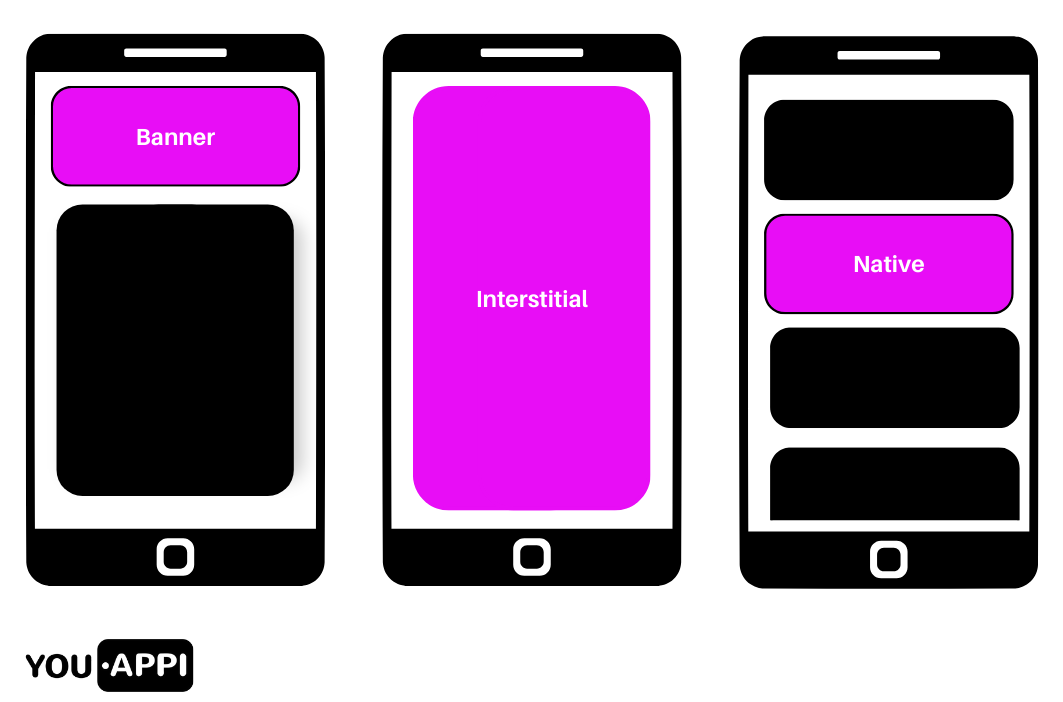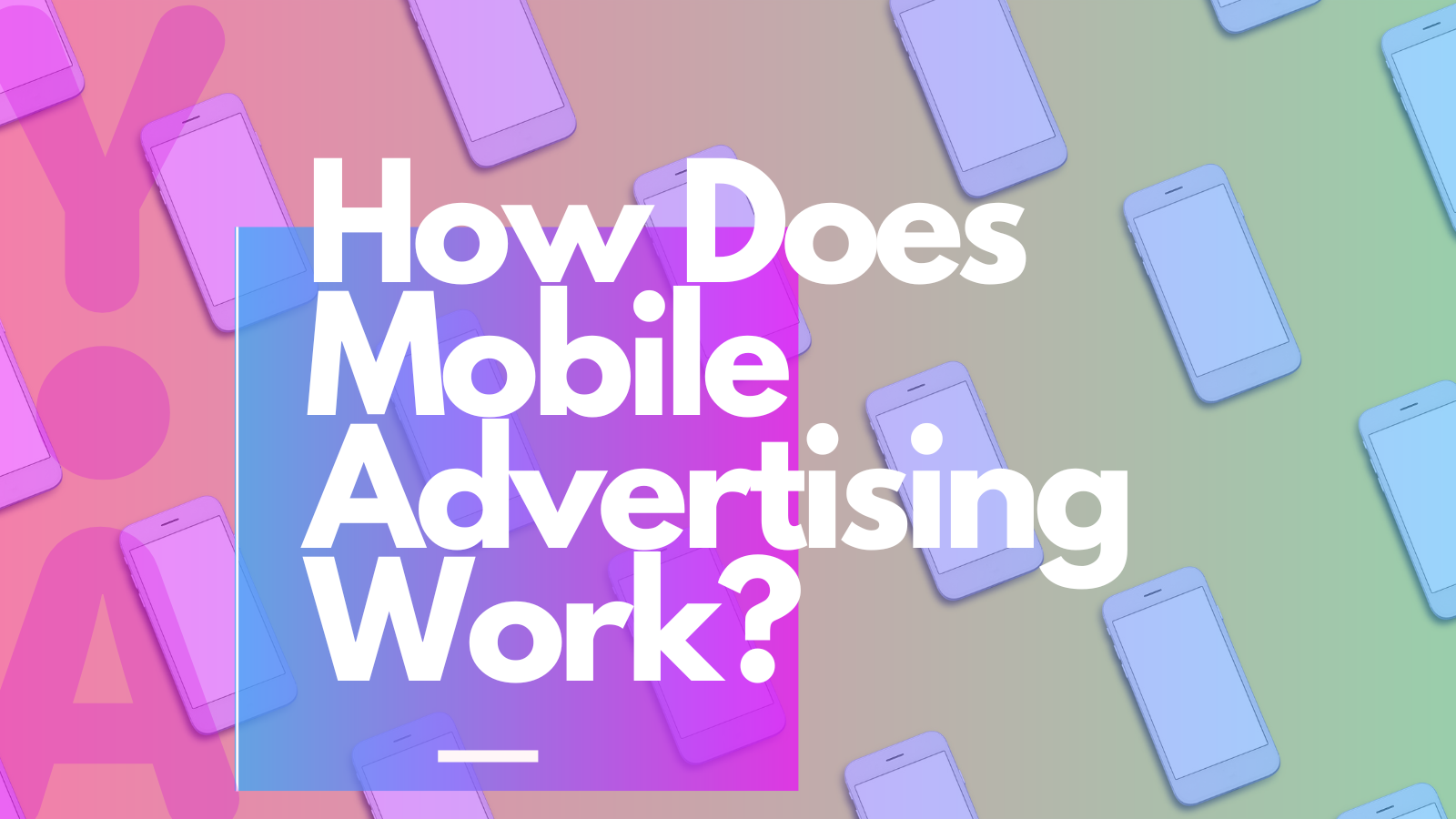It’s estimated that almost 84% of the world’s population owns a smartphone. On top of that, the average person clicks, taps, or swipes 2,617 times per day. With people fixated on their phones for much of the day, there are massive opportunities for advertisers.
There are three primary objectives when it comes to advertising – to inform, persuade, and remind consumers about a brand and its products. Mobile advertising is a type of digital marketing advertising that targets consumers with advertisements where they are already spending their time, on mobile devices. The key to winning the advertising game is to aim ads to where a brand’s target audience can be found.
Find out here how mobile advertising increases brand awareness and higher revenues while simultaneously cutting costs.
What is Mobile Advertising?
Mobile advertising is a type of digital marketing advertising that targets consumers with advertisements for a product or service while they browse their smartphone, tablet or other mobile device. It can involve mobile search ads, social media ads, in-app and text advertisements. The purpose of mobile advertising is to reach consumers where they are already spending their time.
Mobile advertisements tend to involve short and concise videos or messaging in order to capture a users’ attention right away. A unique aspect of mobile advertising is that users can click ads and be sent directly to a location within that app through deep linking. Deep links are types of links that send users directly to an app, or desired location inside an app, instead of a general location, like a website or homepage. Because of deep links, mobile advertisements are an extremely effective tool to engage users within an app and improve the user journey.
Methods of Mobile Advertising Pricing
There are numerous methods of measuring mobile advertising effectiveness and reach. The top four pricing models of mobile advertising strategies are cost per click, cost per mille, cost per install and cost per action. Marketers can pick their pricing method based on their long term goals of their campaigns.
- Cost per click (CPC): With the CPC method, every click on a mobile advertisement incurs a charge to the advertiser, regardless of whether the click results in a lead or sale.
- Cost per mile (CPM): The advertiser pays the fixed amount for thousand impressions of their ad upfront before the campaign begins.
- Cost per install (CPI): The cost per install charges the advertiser for each download of an app the advertiser promotes. These ads typically include some sort of incentive for the user, like rewards or points, to get them to download the app.
- Cost per action (CPA): With this payment model, publishers charge advertisers only after a prospective customer takes a specified action. Actions include signing up for an offer, downloading an offer or completing a purchase.
Why is Mobile Advertising Important?
Mobile advertising differs from other kinds of advertising because it targets users with extremely specific ads on their smartphones or other mobile devices. Not only can mobile advertising be hyper-personalized, it can also be cost effective, trackable, and functional with numerous ad format options when compared with other forms of advertising.
Personalization
Personalization adds value to any advertising campaign because it centers the consumer in the advertising experience. Personalized advertisements have a higher conversion rate at 20% compared to the typical 5%. Mobile advertising as a digital marketing advertising tactic allows for a personalized experience because marketers can look at the location of specific users, browsing history and other indicators that can help tailor ads.
Geo-targeting specifically is a huge advantage of mobile advertising. When marketers know the location of a user, they can deliver time-specific and location-specific communications, such as event announcements or discount alerts. By identifying and targeting specific, relevant audiences and delivering them individualized experiences, campaigns become extremely effective.
Cost Effectiveness
Mobile advertising is appealing to many marketers because of its cost effectiveness. Because mobile screens are smaller than billboards, televisions or other advertising spaces, mobile ads are typically cheaper and faster to create. This means there are more opportunities for app marketers to test out different creative strategies and iterate based on results.
The low costs of mobile advertising makes it much more appealing to apps that do not have large advertising budgets or want to experiment with new ideas. These app marketers can create marketing campaigns that are simple, direct, and effective for a reasonable price.
Trackability
Tracking the effectiveness and response to an advertising campaign are extremely important in deciding whether or not it was a success. Mobile advertising allows marketers to see what is working with a specific ad in real time, rather than waiting for a customer survey. Consumer information such as shopping habits, preferences, and behavior towards an ad are all tracked within mobile advertising and digital marketing advertising.
Because mobile devices are unique to each consumer, data generated by mobile devices is more accurate than that of a desktop or other device. Tracking consumer data helps app marketers make necessary changes to their advertising creatives and messaging to have the maximum return on investment.
Various Ad Formats
Another advantage of mobile advertising includes the ability to choose from various ad formats. These ad formats include banner ads, interstitial ads, and native ads. Being able to experiment with the types of ads displayed helps marketers learn what their target audience resonates with. It also creates room for innovation and creativity.
Banner ads are typically displayed across the top or bottom of the mobile device’s screen. Interstitial ads, on the other hand, take up the entire screen. While interstitial ads practically guarantee attention for your ad, they can also interrupt the user’s mobile experience and cause them to click out before reading the ad. Native ads are ads that are cohesive with the page content and assimilated into the design so that the user might not notice it right away.

One of the most popular mobile ad formats to use on mobile is video ads. Ads with heavy copy are more difficult to read on a mobile screen, hence the appeal of video. The video format is capable of conveying a message consistently and quickly across different platforms on mobile.
Takeaways of How Mobile Advertising Works
Mobile advertising is a type of digital marketing advertising that targets consumers with advertisements where they are already spending their time: on mobile devices. Not only can mobile advertising be hyper-personalized, it can also be cost effective, trackable, and function with numerous ad format options when compared with other forms of advertising.
- Personalization: Personalized advertisements have a higher conversion rate at 20% compared to the typical 5%. Mobile advertising allows for a personalized experience because marketers can look at the location of specific users, browsing history and other indicators that can help tailor ads.
- Cost Effectiveness: Mobile advertising is appealing to many marketers because of its cost effectiveness. The low price allows for app marketers to test out different creative strategies and iterate based on results.
- Trackability: Tracking the effectiveness and response to an advertising campaign are extremely important in deciding whether or not it was a success. Consumer information such as shopping habits, preferences, and behavior towards an ad are all tracked within mobile advertising and digital marketing advertising.
- Various Ad Formats: Being able to experiment with the types of ad formats helps marketers learn what their target audience resonates with. It also creates room for innovation and creativity.

